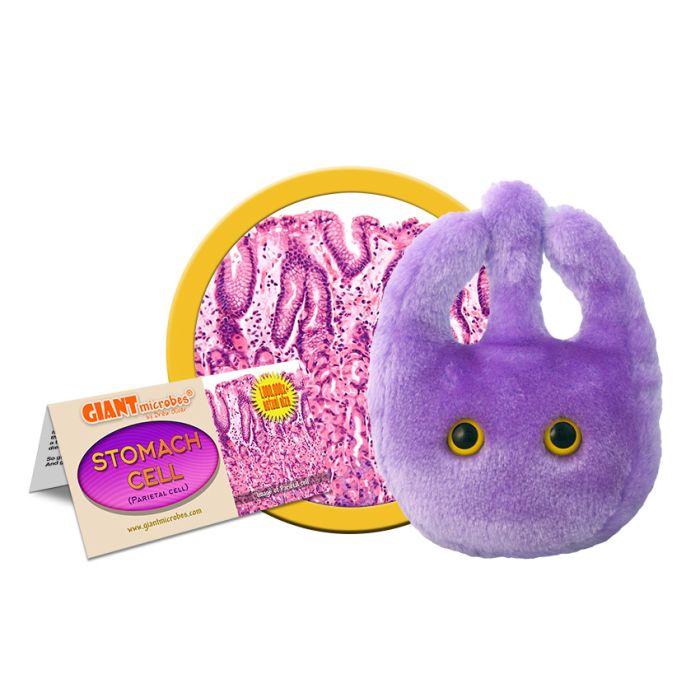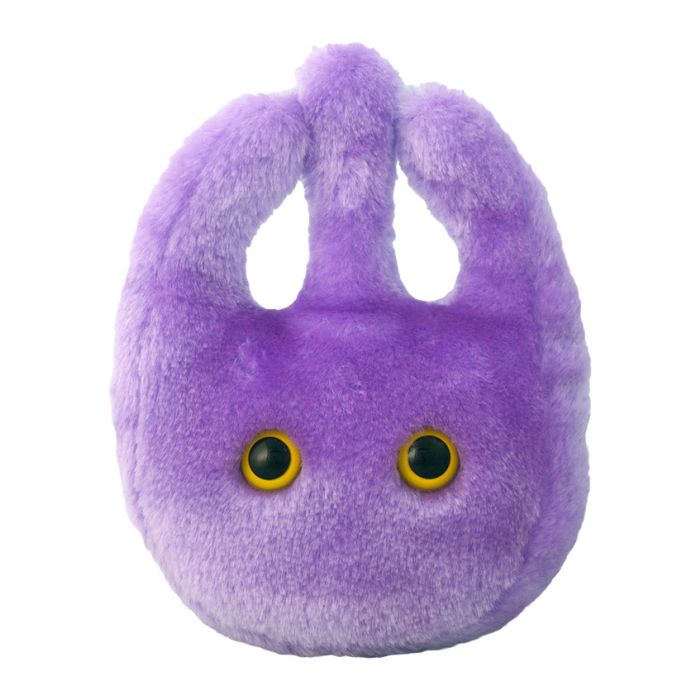Stomach Cell (Parietal cell)
Out of Stock
Product Details
Additional Information
| Sizes | Giantmicrobes are based on actual microbes, cells, organisms and other critters, only 1,000,000 times actual size! Gigantic (GG) 40-60cm XL (XL) 25-38cm Original (PD) 12-20cm Minis (MM) 5-10cm each Keychain (KC) 5-10cm with clip |
|---|---|
| Materials | Plush from all new materials. Stuffed with polyester fiber fill. Surface washable: sponge with water & soap, air dry. |
| Packaging | Each plush microbe includes a printed card with fun, educational and fascinating facts about the actual microbe or cell. |
| Safety | Every product meets or exceeds U.S. and European standards for safety. For ages 3 and up. |
All about Stomach Cell (Parietal cell)
FACTS: The stomach receives, holds and partly digests food. This pouch-like organ is actually small, but as you eat the stomach wall quickly stretches to hold up to 3/4 gallon or 3 liters. It churns and mixes food with acids and enzymes. The powerful muscles lining the stomach mash food, breaking up fats and proteins. Orange juice… how about some stomach juice?! When you see or smell food, tiny stomach glands secrete gastric juice. This stomach juice is mostly hydrochloric acid with a touch of the enzyme pepsin that digests proteins. The acid activates pepsin, breaks down food, and also kills germs. Your stomach produces up to 3 liters of gastric juice every day. Mucous cells that line the stomach protect it from the acid, so that the stomach doesn’t digest itself!
Compared to other creatures, the human stomach is not too exciting. The blue whale’s stomach can hold 2,000 pounds of food. The cow’s stomach is divided into four distinct sections that hold grass-chomping microbes. The jellyfish’s gastric cavity converts food into a soupy liquid that’s transferred directly into its circulatory system; leftovers are expelled back out of the jellyfish’s stomach the same way they came in. Or how about the python’s stomach, which can stretch enormously to hold a fully intact, 80-pound deer!
| Description | The stomach is a muscular sac that is a key player in digestion. Its job is to churn food to a consistency that makes it easier to breakdown throughout the rest of the digestive tract. It can expand to temporarily store food and release enzymes to begin chemical breakdown of the consumed substance. |
|---|
| Name |
The Greek word “stoma” means mouth or gullet. These parts of the digestive tract all lead toward the same place, the stomach. The suffix “ach” actually means pain. This is because centuries ago when detailed anatomy of the abdominal region was not yet understood, most pain was attributed to the stomach. This organ is comprised of four main cell types. Mucous Cells: Secrete specialized mucous to shield the stomach lining from harmful acids. Parietal Cells: Secrete hydrochloric acid that activates the release of an enzyme that breaks down proteins, pepsin. Additionally, it kills micro-organisms that were consumed along with food. Chief Cells: Secrete pepsin for protein digestion. G Cells: Secrete gastrin which triggers the release of hydrochloric acid. |
|---|
| Actual Size | 0.5mm. |
|---|
| System | Digestive system. |
|---|
| History | In 1822 William Beaumont discovered that the stomach digests chemically as well as physically by observing acidic properties of gastric fluid. He experimented with Alexis St. Martin who lived with a hole in his stomach from a gunshot wound. Beaumont was nicknamed the “Father of Gastric Physiology”. Since this initial revolution, many more discoveries have been made that helped explain misunderstood phenomenon and cure debilitating diseases. |
|---|
| Fascinating Facts |
A human can survive without a stomach, it is an expendable organ. When a person blushes with their face, the stomach actually blushes as well. Burping is a release of air swallowed along with food. In some cultures, a loud burp is actually a compliment to the chef. |
|---|





